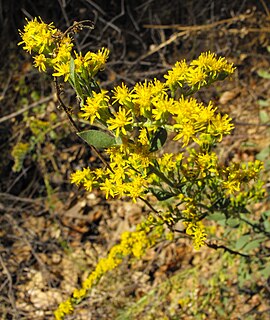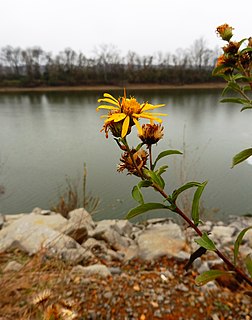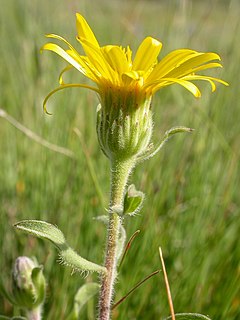| Heterotheca sessiliflora | |
|---|---|
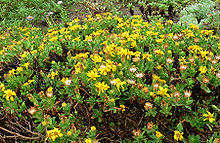 | |
| ssp. bolanderi | |
| Scientific classification | |
| Kingdom: | Plantae |
| (unranked): | Angiosperms |
| (unranked): | Eudicots |
| (unranked): | Asterids |
| Order: | Asterales |
| Family: | Asteraceae |
| Tribe: | Astereae |
| Genus: | Heterotheca |
| Species: | H. sessiliflora |
| Binomial name | |
| Heterotheca sessiliflora | |
| Synonyms [1] | |
Synonymy
| |
Heterotheca sessiliflora is a species of flowering plant in the daisy family known by the common name sessileflower false goldenaster. It is native to California, Sonora, and Baja California. [2] [3] [4]

Asteraceae or Compositae is a very large and widespread family of flowering plants (Angiospermae).

California is a state in the Pacific Region of the United States. With 39.6 million residents, California is the most populous U.S. state and the third-largest by area. The state capital is Sacramento. The Greater Los Angeles Area and the San Francisco Bay Area are the nation's second and fifth most populous urban regions, with 18.7 million and 9.7 million residents respectively. Los Angeles is California's most populous city, and the country's second most populous, after New York City. California also has the nation's most populous county, Los Angeles County, and its largest county by area, San Bernardino County. The City and County of San Francisco is both the country's second-most densely populated major city after New York City and the fifth-most densely populated county, behind only four of the five New York City boroughs.
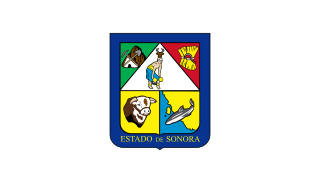
Sonora, officially Estado Libre y Soberano de Sonora, is one of 31 states that, with Mexico City, comprise the 32 federal entities of United Mexican States. It is divided into 72 municipalities; the capital city is Hermosillo. Sonora is bordered by the states of Chihuahua to the east, Baja California to the northwest and Sinaloa to the south. To the north, it shares the U.S.–Mexico border with the states of Arizona and New Mexico, and on the west has a significant share of the coastline of the Gulf of California.
Heterotheca sessiliflora grows in many types of habitats. It is a perennial herb which is quite variable in appearance, particularly across its four subspecies. It may be a small clumping or mat-forming plant or grow tall stems to heights exceeding a meter. It is coated in small bristles or long woolly hairs and it is glandular, particularly around the inflorescence. The flower head contains long yellowish disc florets and the edge is fringed with yellow ray florets. [5]

An inflorescence is a group or cluster of flowers arranged on a stem that is composed of a main branch or a complicated arrangement of branches. Morphologically, it is the modified part of the shoot of seed plants where flowers are formed. The modifications can involve the length and the nature of the internodes and the phyllotaxis, as well as variations in the proportions, compressions, swellings, adnations, connations and reduction of main and secondary axes. Inflorescence can also be defined as the reproductive portion of a plant that bears a cluster of flowers in a specific pattern.
- Subspecies + varieties [1] [2]
- Heterotheca sessiliflora subsp. bolanderi(A.Gray) Semple San Francisco Bay area + coast of Redwood Country
- Heterotheca sessiliflora subsp. echioides(Benth.) Semple - from San Diego County to Sonoma County
- Heterotheca sessiliflora subsp. fastigiata(Greene) Semple - mountains of southern California
- Heterotheca sessiliflora var. sessiliflora
- Heterotheca sessiliflora subsp. sessiliflora - from Baja California north as far as Santa Clara County
- Heterotheca sessiliflora var. thiniicola(Rzed. & C.Ezcurra) G.L.Nesom - Gran Desierto de Alta northwestern Sonora [3] [6]
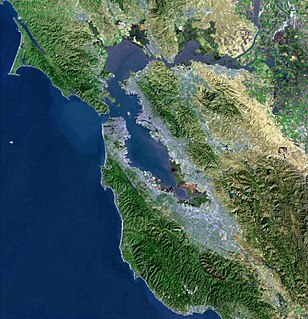
San Francisco Bay is a shallow estuary in the US state of California. It is surrounded by a contiguous region known as the San Francisco Bay Area, and is dominated by the large cities of San Jose, San Francisco and Oakland.
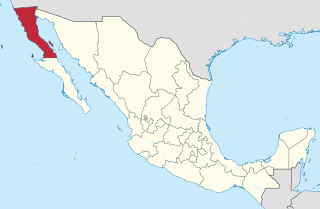
Baja California, officially the Free and Sovereign State of Baja California, is a state in Mexico. It is the northernmost and westernmost of the 32 Federal Entities of Mexico. Before becoming a state in 1952, the area was known as the North Territory of Baja California. It has an area of 70,113 km2 (27,071 sq mi), or 3.57% of the land mass of Mexico and comprises the northern half of the Baja California Peninsula, north of the 28th parallel, plus oceanic Guadalupe Island. The mainland portion of the state is bordered on the west by the Pacific Ocean, on the east by Sonora, the U.S. state of Arizona, and the Gulf of California, and on the south by Baja California Sur. Its northern limit is the U.S. state of California.






